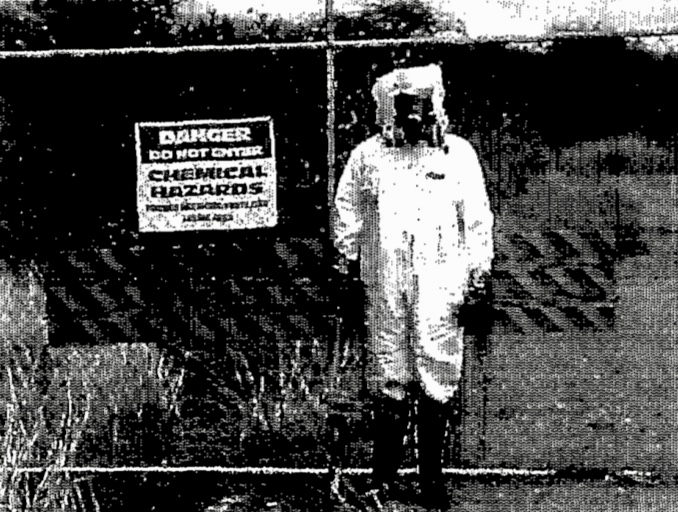- (Above photo: An employee of BEI Environmental Services in protective gear at O‘ahu Sugar Company’s former pesticide and herbicide mixing plant on the Waipi‘o Peninsula. The company collected soil and water samples in 2000. Credit BEI)
In July 2001, Environment Hawai‘i reported on contamination at O‘ahu Sugar’s pesticide mixing and loading site in East Kapolei, detailing how each chemical with concentrations that exceeded acceptable limits might affect human health and other organisms.
At the company’s chemical mixing site at the Waipi‘o Peninsula, soil samples collected by the state Department of Health and BEI Environmental Services also had dioxin, pentachlorophenol and other toxins in concentrations that far exceeded levels that require some kind of action under state and/or federal guidelines:
Dioxins/furans: Dioxin, a byproduct of pesticide manufacturing, can persist in the environment for a long time. According to an EPA fact sheet, it’s half-life in soil is on the order of five to ten years.
In 1997, the DOH found three soil samples from the Waipi‘o site had dioxin levels of 98.9 parts per billion (ppb), 234 ppb, and 1,530 ppb, respectively. Sam- pling by BEI Environmental Services in 2000 found dioxin/furan levels as high as 10.55 ppb to 992 ppb.
The state Department of Health’s screening level for dioxin is 10 ppb and the 2004 EPA Region 9 Industrial Preliminary Remediation Goal (PRG) is 0.016 ppb.
As we reported back in 2001, the EPA has found that short-term exposure to dioxin above allowable levels can cause liver damage, weight loss, and wasting of glands important to the body’s immune system. Long-term exposure at amounts above allowable levels can cause cancer and a variety of reproductive effects, from impaired fertility to birth defects.
Pentachlorophenol (PCP): Dioxin is a common contaminant found in the pesticide pentachlorophenol or PCP. Two soil samples from the DOH’s
1997 survey had PCP levels — 35 parts per million (ppm) and 8.4 ppm
— that exceed the EPA’s action level of 11,000 ppb. BEI’s sampling found
PCP in surface soils at levels between 37 ppb and 140,000 ppb. And at four locations, PCP levels exceeded the EPA’s Industrial PRG of 9,000 ppb.
In comparison, PCP concentrations in soils at O‘ahu Sugar’s East Kapolei site ranged from 8,100 ppb to 17,000 ppb.
Pentachlorophenol is known to cause cancer and birth defects in lab animals, as well as chromosome abnormalities, blood disorders, and nerve damage in humans.
Organochlorine Pesticides: 4,4’- DDE, 4,4’-DDD, and 4,4’-DDT were detected in nine of BEI’s samples. The latter two chemicals were found in concentrations above the EPA’s respective 1,800 ppb and 820 ppb PRGs. One sample had a 4,4’-DDD level of 2,900 ppb. Another sample had a 4,4’-DDT level of 1,500 ppb.
According to the Agency for Toxic Substances and Disease Registry, “The International Agency for Research on Cancer determined that DDT may possibly cause cancer in humans. The EPA determined that DDT, DDE, and DDD are probable human carcinogens.”
Hydrocarbons: BEI found levels of benzo(b)fluoranthene, benzo(a)anthracene, and benzo(a)pyrene in soil samples that exceeded acceptable levels.
Benzo(b)fluoranthene is a probable carcinogen in humans and has been shown to cause lung, liver and skin cancer in animals. Benzo(a)anthracene has been found to be genotoxic and to cause tumors in the liver, skin and lungs of young mice. Benzo(a)pyrene is a carcinogen in humans.
Lead: BEI found excessive lead contamination in two soil samples. Depending on the concentration, “lead can adversely affect the nervous system, kidney function, immune system, reproductive and developmental systems and the cardiovascular system. Lead exposure also affects the oxygen carrying capacity of the blood,” according to the EPA.
— T.D.


Leave a Reply